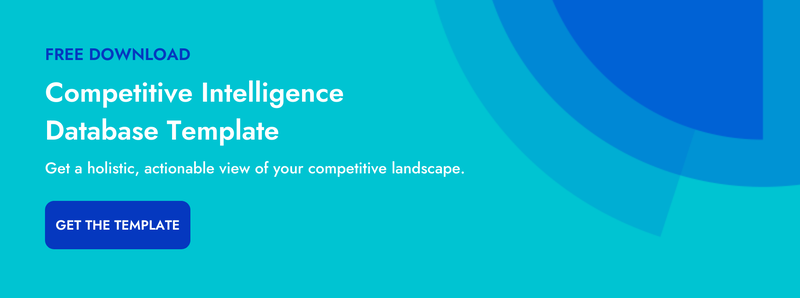All too frequently, competitive intelligence (CI) information resides in many homes. The process of collecting competitive intelligence can be time consuming when the information lives across multiple platforms and formats. Not only is keeping track of it all a bit hectic, but we have less than optimal visibility across those sources, making it harder to track our competitive landscapes in real-time. That's why creating a (mostly single-stop) home is key to maintaining your intel and generating ongoing analyses of your competition. While the most effective way to achieve this is to leverage a competitive intelligence platform, these templates are a great starting point. Read on to learn how to create a centralized competitive database.
Advantages of a Competitive Database
One of the game-changing aspects of creating a competitive intelligence database is that it makes it easier to engage with your competitive intel. The nature of tracking competitors encourages a natural tendency to get lost in the details since that is where you live every day. When you pull all of your raw data and information together, you break that habit and recognize new patterns in your broader market that you might otherwise have missed.
Another type of short-sightedness that can emerge in gathering competitive intelligence is an intense focus on top tier competitors to the exclusion of players on a lower rung. When conducting competitive intelligence research, you should break down your competitive landscape into tiers, including direct, indirect, aspirational, and perceived competitors. Using a database to keep track of the fledgling but potential disruptors in your space can give you massive strategic value. While the greatest threat is the one you don't see, the greatest disappointment is the one that you should have.
Developing a picture of your broader competitive landscape by creating a database also helps educate you and your team on your indirect competition. Organizations that might seem tangential since you may not compete with them in the same deals can still inform buying decisions, particularly from a budgeting perspective. After all, you may be fighting for a piece of the same budget with your products, services, and solutions with indirect competitors and partners. Helping buyers prioritize your offerings over others requires a broader understanding of your competition – even the products from your indirect competition.
At a more tactical level, the simple act of laying out your competitors’ side by side, while also benchmarking your own activity, frequently yields surprising insights. Crowded market sectors, offering categories, and feature sets jump off the page. Similarities and subtleties in messaging and positioning expose gaps for immediate differentiation in marketing materials and sales deals. Thus, the competitive database can generate a more expansive perspective and more detailed guideposts.
Making the Time to Centralize Your Competitive Database
You may be thinking to yourself that creating a competitive database will take too much time out of your schedule, as will maintaining it. The latter point is easier to tackle first. You’re likely already collecting the bulk of the information and data that will live in your database. You’re only relocating it to a central repository that will actually make it easier to maintain and expand in the long-term. Whatever new intel is added only enriches and adds dimensionality to your understanding of your market and your competition. Plus, if you can put aside 10 minutes per day to focus on competitive intelligence, you’re already on the right track.
While creating your database might seem a little intimidating at first, you should consider some of the obvious and not-so-obvious benefits.
- You’ll likely find that “spring cleaning” is a great way to re-evaluate your current approach and thinking, since you’ll be seeing how you work with a fresh set of eyes.
- You’ll probably rediscover pieces of the puzzle that have slipped from the forefront of your mind.
- You may surface some information that has become an unquestioned assumption long ago has become less important or even irrelevant.
- You will be forced to reconsider your methodology, which can then reinvigorate how you tackle (and enjoy!) your day-to-day work.
If you start to lose steam in the process, take a moment to imagine your destination: where you’ll have a more holistic understanding of your market and the ability to create higher-order analysis more quickly.
What to Include in Your Competitive Database
The structure of your database will likely consist of some fields that are desirable across all businesses, and some that will be more specific to your needs.
A basic competitive database will include:
- Go-to-Market Insights: Categories, Offerings, Use Cases, Segments, Verticals, Customers, and Partners
- Business Overview: HQ Location, Founded, Private/Public, Funding (if private), Revenues, Employees, Competitive Tier, and Competitor Type
- Product: Products, Pricing, Features, and Claims
- Marketing: Messaging, Boilerplate, Websites, and Events
- Competitive Analysis Outputs: Strengths, Weaknesses, Opportunities, Threats, Key Takeaways, Questions to Ask, Landmines, and Questions to Expect
Each of these areas has some embedded use cases across your organization. For instance, providing a basic snapshot of competitors from the business overview section has a broad educational utility. The combination of the competitive tier with direct/indirect assignments allows for an easily digestible matrix of your overall competitive space across teams and new hires.
The go-to-market section gives you an outline of where your competitors fit in your market. Your executive leadership, marketing, sales, and product management teams will benefit from this deeper understanding. It will allow them to direct strategy, target prospects, enhance offerings, and set the course for your company’s future. Similarly, product, marketing, and analytical outputs can drive all sorts of vital explorations from positioning exercises to launch timelines to tactical discussions in field discussions.
From there, you can flesh out additional areas that you either track today or would like to start tracking in a more organized fashion. Ideally, these would grow out of your primary audiences, your existing business and go-to-market strategy, and the structure of your team and organization. You might also find value in creating fields to feed standard competitive analysis deliverables like battlecards and competitive profiles that you produce so that you can update once and copy/paste into those assets.
Formats for Your Centralized CI Database
There are many ways to organize your competitive intelligence database. Depending on your team’s current tech stack, it’s possible to create a centralized competitive database in a format you’re already comfortable with. To make it simple to track and keep in one centralized location, we’ve created three templates that should make this project easier.
Google Sheets or Microsoft Excel: These two formats are similar, but really up to the user which format they prefer. Both are organized spreadsheets with an instruction page, already set-up tabs for Competitors, Go-To-Market insights, Customers + Partners, a Competitive Matrix, etc.
Airtable: Airtable, a personal favorite here at Crayon, is a great tool for project management, calendars, and more. In the Airtable, you’ll find similar presets to the above spreadsheets, plus some new ones. What's great about entering data in Airtable is that you don't have to go to the tab to enter new picklist items – you can add them inside any picklist field, and the corresponding table will automatically be updated.
Competitive intelligence data is vast and ever-changing. The key to keeping a competitive edge is collecting competitive intelligence data and maintaining a singular database. Download our free centralized competitive database template in your choice of Excel, Google Sheets, or Airtable. If you want to take your competitive intelligence to the next level, Crayon can collect and centralize all of your competitive intelligence insights for you. Whether you choose to do this manually or leverage a CI platform, you’re guaranteed to out-market your competition.
Originally published on January 15, 2019 by Tom Heys. Updated on September 16, 2020 by Emily Dumas.

Related Blog Posts
Popular Posts
-
 How to Create a Competitive Matrix (Step-by-Step Guide With Examples + Free Templates)
How to Create a Competitive Matrix (Step-by-Step Guide With Examples + Free Templates)
-
 The 8 Free Market Research Tools and Resources You Need to Know
The 8 Free Market Research Tools and Resources You Need to Know
-
 Sales Battlecards 101: How to Help Your Sellers Leave the Competition In the Dust
Sales Battlecards 101: How to Help Your Sellers Leave the Competition In the Dust
-
 6 Competitive Advantage Examples From the Real World
6 Competitive Advantage Examples From the Real World
-
 How to Measure Product Launch Success: 12 KPIs You Should Be Tracking
How to Measure Product Launch Success: 12 KPIs You Should Be Tracking





